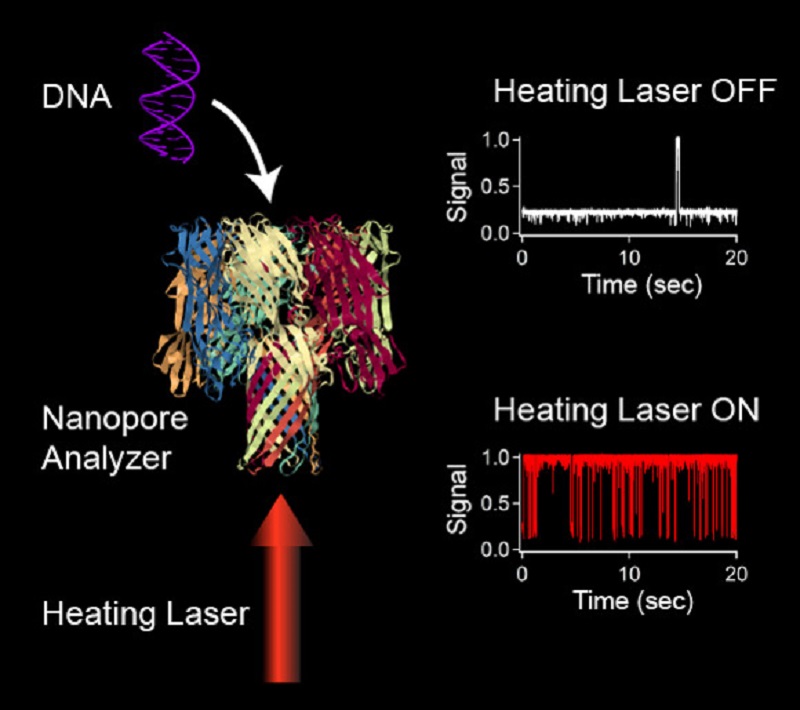Feb 22 2016
 DNA molecules enter into the pore and cause the current signal to decrease. At room temperature, double-stranded DNA molecules remain in the pore for long periods of time, which makes it difficult to analyze a DNA mixture. Focusing a heating laser onto the nanopore speeds up the interaction of the DNA with the pore and yields a far greater number of events that can be analyzed to identify the DNA molecules in solution. (DNA and nanopore analyzer images reproduced from the PDB: 10.2210/pdb2m2c/pdb and 10.2210/pdb7ahl/pdb respectively).
DNA molecules enter into the pore and cause the current signal to decrease. At room temperature, double-stranded DNA molecules remain in the pore for long periods of time, which makes it difficult to analyze a DNA mixture. Focusing a heating laser onto the nanopore speeds up the interaction of the DNA with the pore and yields a far greater number of events that can be analyzed to identify the DNA molecules in solution. (DNA and nanopore analyzer images reproduced from the PDB: 10.2210/pdb2m2c/pdb and 10.2210/pdb7ahl/pdb respectively).
A team of researchers from Virginia Commonwealth University have formulated a novel method to examine DNA molecules. Their research paper titled, “Infrared laser heating applied to nanopore sensing for DNA duplex analysis,” discusses the method for improved forensic DNA workflows to gain much faster and precise identification. The paper has been published in the Analytical Chemistry journal, and was available online from 19th February.
We are interested in increasing the number of parameters that researchers can tune in order to study small DNA molecules. Laser heating has been used in the past, so we applied this methodology to our nanopore technique and found it was effective at discriminating between different sized DNA fragments.
Joseph Reiner, Ph.D., Assistant Professor of Physics, Virginia Commonwealth University
Researchers can improve their knowledge about the chemical and physical properties of molecules in solution using nanopore sensing. A nanopore can be defined as a tiny hole with an ionic current. When it is introduced into a solution sample, DNA molecules from the solution pass through it, causing an alteration in the current.
Researchers can obtain data about the molecule based on the alteration in current, and the duration that the molecule remains in the nanopore. In this study, the team were keen to examine the size of the molecules.
One of the challenges with DNA nanopore sensing is that sometimes the molecules stay in the hole. The speed at which the molecules drift can be tweaked using many methods, such as heating the sample solution. This helps to control the interaction time between the pore and the DNA, and enables the various types of DNA molecules in a given sample to be identified in a highly precise manner.
Bathing the entire solution in heat has its disadvantages, including slow heating, cooling times, and solution evaporation. Infrared laser heating provides a solution to these issues, as the energy is focused on the sample even its volume is very low, enabling fast and isolated application of heat.
The laser can localize the heat down onto the pore, which gives us much better control over the frequency of DNA events and the time a DNA molecule remains in the pore. By analyzing each of these events, we hope to characterize the number and size of different DNA molecules in a solution.
Joseph Reiner, Ph.D., Assistant Professor of Physics, Virginia Commonwealth University
According to Sarah Seashols-Williams, Ph.D., co-author on the article and Assistant Professor in the Department of Forensic Science, the latest technique of forensic DNA profile development is based on discrimination of the DNA fragment size. Seeing the different sizes of the DNA fragments known to distinguish between people, would lead to knowing if the sample has DNA from one or more people. Forensic researchers can utilize this data can as a prescreening tool to take accurate measures for further examination and workflow.
At this moment, researchers do not have the prescreening method, and have to spend a lot of time and resources and perform more tests to gain knowledge about the DNA found on evidence.
Researchers are hoping to provide information prior to the manpower and cost of the traditional analysis method so they can better use resources. That will also help reduce backlogs because they’re able to work more quickly, using only the procedures that will provide information for that sample.
Sarah Seashols-Williams, Ph.D., Assistant Professor, Department of Forensic Science, Virginia Commonwealth University